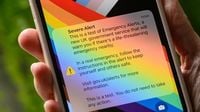On Sunday afternoon, September 7, 2025, a sudden siren pierced the air across the United Kingdom, startling millions of people from the Scottish Highlands to the tip of Land's End. It wasn’t the start of a disaster movie, nor was it a false alarm. Instead, it was the UK government’s second test of its national Emergency Alert system—a bold step in the ongoing effort to keep citizens safe when danger looms.
For many, the alert was a brief interruption, a ten-second blast that vibrated through pockets, handbags, and, in some cases, even interrupted moments of silence in places like the British Library. As reported by BBC, the alert’s reach was impressive: it rang out not only in remote areas but even several thousand feet up in the air, surprising one flying lesson participant over Kent. Sporting events were momentarily halted, and passengers riding deep beneath London in the tube received the message, a testament to the system’s wide coverage.
The government’s Emergency Alert system is designed for precisely these moments—when every second counts and lives are at stake. The system sends a siren-like sound and a message directly to mobile phones, warning people about imminent threats such as wildfires, severe flooding, extreme storms, or terror attacks. According to government statements cited by LADbible, the system "represents an important tool for keeping communities safe, and this test helps ensure it will be ready when we need it most."
This latest test follows the first national trial, which took place in April 2023. Since then, the system has already been put to the test in real-world situations. The government reports that five genuine alerts have been sent during major storms, when lives were genuinely at risk. These real-world deployments underscore the seriousness of the system’s purpose and the government’s commitment to public safety.
Prime Minister Sir Keir Starmer praised the effort, stating that "tens of millions of phones successfully sounded across the country," and called the test "an important step in keeping people safe during national emergencies." His sentiment was echoed by Pat McFadden, the new Work and Pensions secretary, who described the system as "a vital tool for keeping the nation safe when lives are on the line – and every minute matters."
But not everything went off without a hitch. While the majority of users received the alert as intended, some people encountered problems. BBC’s science reporter Esme Stallard and a handful of others received garbled messages, and there were isolated reports of the alert going off twice on some devices. A government spokesperson responded to these concerns, stating that "the alert message was broadcast correctly and mobile operators have confirmed that the test ran as expected," adding that there was "no evidence of widespread errors."
For some, the surprise was less about the message and more about where and how it arrived. One reader recounted receiving the alert in a remote corner of Land’s End, while another was surprised to hear it blare through their hearing aids, startling both them and their snoozing pets. The system’s ability to reach so many, even in isolated or unusual locations, was generally met with approval. As the BBC noted, many readers were impressed by the system’s reach, though a few were confused by its intrusion into traditionally quiet spaces.
Not everyone, however, received the alert. The government acknowledges that some devices—particularly older phones or those not connected to 4G or 5G networks—may not be compatible with the system. As LADbible points out, "not all devices get it through," meaning a portion of the population could remain unaware during a real emergency. This technological limitation is not unique to the UK; similar systems in other countries have faced comparable challenges as technology evolves and older devices become obsolete.
Despite these minor hiccups, the government remains optimistic about the system’s effectiveness. Regular tests, officials argue, are crucial for ensuring that the alert reaches as many people as possible when it matters most. The cell broadcast technology used by the system allows messages to be sent without the government needing to know users’ locations or phone numbers, preserving privacy while maximizing reach. The government has emphasized, "While the brief interruption on Sunday afternoon might be inconvenient, it's a small price to pay for a system that could one day help save lives."
The Emergency Alert system’s importance is underscored by the increasing frequency and severity of natural disasters. In recent years, the UK has faced devastating floods, powerful storms, and even wildfires—events that have put lives and property at risk. In such situations, timely warnings can make the difference between safety and tragedy. The government’s focus on refining and improving the alert system reflects a broader commitment to disaster preparedness in an era when climate change is making extreme weather more common.
Public reaction to the test has been mixed but largely positive. Some users found the alert disruptive, especially when it interrupted quiet moments or startled pets. Others, however, saw the brief inconvenience as a necessary trade-off for a system that could one day save lives. As one commentator put it, "it’s a relatively useful tool to have nationally." The government’s message is clear: the safety of the nation comes first, and the Emergency Alert system is a key part of that strategy.
Looking ahead, officials plan to continue regular testing and to address any technical issues that arise. The goal is to ensure that, when a real emergency occurs, the system will work flawlessly, reaching as many people as possible with clear, actionable information. As technology advances and more devices become compatible, the reach and reliability of the system are expected to improve further.
The UK’s approach to emergency alerts is part of a global trend. Countries around the world are investing in similar systems, recognizing that timely, accurate information can be the most powerful tool in a crisis. Whether it’s a wildfire racing toward a village, a flood threatening a city, or a terror attack unfolding in real time, the ability to warn people quickly and efficiently is vital.
For now, the sound of a siren on a quiet Sunday afternoon serves as a reminder: preparedness is key, and technology—when harnessed responsibly—can be a powerful ally in protecting lives. As the UK government fine-tunes its Emergency Alert system, the nation moves one step closer to ensuring that, when danger strikes, help is only a message away.


